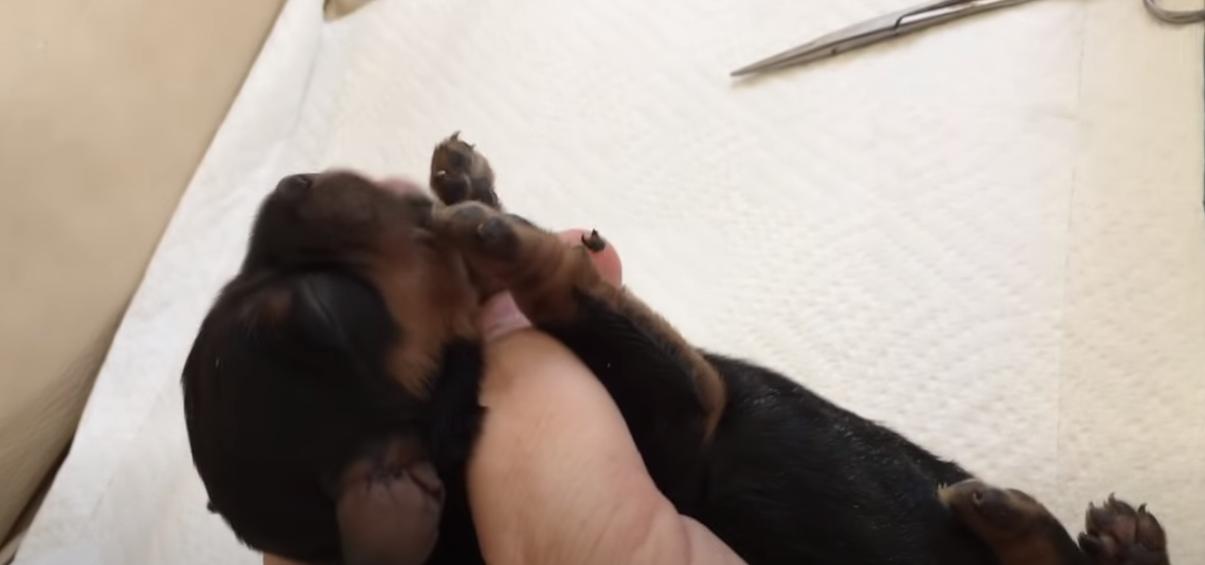Do Rottweilers Have Dew Claws? (Explained!)
There is some debate over whether or not Rottweilers should have their dew claws removed. Dew claws are the small, claw-like appendages that can be found on the inside of a dog’s leg, near the paw.
Some people believe that dew claws serve no purpose and should therefore be removed, while others believe that they can actually be beneficial to a dog’s health and wellbeing.
Most veterinarians agree that dew claws on the rear legs of a Rottweiler should be removed, as they are typically very weak and can easily get injured or torn off. However, there is less consensus when it comes to front dew claws.
Some people choose to remove them for aesthetic reasons or because they believe it may help prevent injuries, while others leave them intact because they think it looks natural or provides additional support for the leg.
Ultimately, it is up to each individual owner to decide whether or not to remove their Rottweiler’s front dew claws.

What are dew claws?
Dew claws are a toe on the back legs of some mammals, including dogs and cats. They are thought to be vestigial remnants of a fifth toe. While they serve no purpose in modern animals, dew claws can be helpful in certain activities, such as climbing or grasping prey.
Do all dogs have dew claws?
All dogs have dew claws on their front legs. Some breeds of dogs also have dew claws on their hind legs. Dew claws are typically perceived as ‘abnormal’ on other breeds of dogs. However, there is no evidence that suggests that dew claws are harmful to a dog’s health.
In fact, some veterinarians believe that dew claws can actually provide additional stability and traction for a dog when they are running or climbing.
Why are dew claws removed on some dogs?
Dew claws are typically removed on dogs in order to prevent them from being injured while running through brush or tough terrain.
Rear dewclaws are commonly seen in breeds such as the Great Pyrenees, St. Bernard, Icelandic Sheepdogs, Briard, and a few others.
While dewclaw removal is not a necessary procedure for all dogs, it can be beneficial for those who are prone to injuries in these areas.
Are there any benefits to leaving dew claws intact?
Dew claws are the small, claw-like toes that some dogs have on the back of their feet. While they may look like they serve no purpose, dew claws can actually be beneficial for certain dogs.
For example, working dogs such as police K-9s or search and rescue dogs often have their dew claws left intact. This is because the extra grip provided by the dew claws can help them better perform their jobs. Dew claws can also be helpful for dogs who live in icy or snowy climates, as they provide additional traction on slippery surfaces.
Breeders may be able to leave dew claws intact upon request. However, it’s important to note that not all breeds of dog have functional dew claws – in some cases, they are nothing more than vestigial digits that serve no real purpose. If you’re interested in having your dog’s dew claws left intact, be sure to speak with a reputable breeder who can accommodate your request.
How are dew claws removed?
Dew claws are typically removed by a breeder or the breeder’s veterinarian at three to five days of age. They can also be clipped off at home with scissors or nail clippers. If done by a veterinarian, they are removed under local anesthesia, clamps, and a scalpel.
The dewclaw is the innermost toe on a dog’s foreleg, and it doesn’t touch the ground when the dog is standing. Some people believe that dewclaws serve no purpose and should be removed for both aesthetic and safety reasons. Others believe that dewclaws help dogs grip toys and provide extra traction when running and climbing.
There are two types of dewclaws: single-digit (one claw per foot) and double-digit (two claws per foot). Double-digit dewclaws are more common in Europe, while single-digit dewclaws are more common in North America. In some cases, double-digit dewclaws may need to be removed because they can get caught on things and tear off painfully.
If you decide to have your dog’s dewclaws removed, it’s important to find a reputable breeder or veterinarian who has experience with this procedure. Dewclaw removal is a relatively simple surgery, but it does require anaesthesia and pain medication for your dog afterwards.
Is the procedure painful for the dog?
The dewclaw is the highest point of the foot on a dog’s leg. It is located on the inside of the front legs and on the outside of the rear legs. The dewclaw is not attached to anything and can be easily ripped off if it gets caught on something.
The procedure to remove a dewclaw is called an amputation. It is a minor surgery that does not require general anesthesia. The dog may experience some discomfort during the procedure, but it is not considered painful.
What are the risks associated with removing dew claws?
There are a few risks associated with removing dew claws. First, there is a risk of infection and scarring at the site of the removed dewclaw. In some cases, regrowth of the nail is possible. Second, removal of front dewclaws can potentially cause issues later in life. The carpal (wrist) ligaments can stretch and tear more easily without a front dewclaw.
How do you care for a dog’s paws after removal of the dew claw(s)?
It is important to check your dog’s paws daily, especially after removal of the dew claw(s). The affected area should be kept clean and dry to prevent infection. You may need to apply a topical antibiotic ointment to the area if there is persistent swelling and/or discharge.
Are there any long-term effects of having dew claw(s) removed?
The removal of dew claws can cause potential issues later in life, such as the stretching and tearing of carpal ligaments, which can lead to arthritis. While there is no definitive answer as to whether or not removing dew claws has any long-term effects, it is certainly something to consider if you are considering this procedure for your pet.
Frequently Asked Questions
How do you pick a quality Rottweiler puppy?
When it comes to choosing a quality Rottweiler puppy, there are a few key things to keep in mind. First and foremost, you’ll want to find a reputable breeder who can provide you with healthy, well-bred puppies. Once you’ve found a good breeder, take the time to meet the parents of the puppies – this will give you an idea of what temperament and personality traits your puppy may inherit.
It’s also important to observe how the puppies interact with their littermates; do they seem like confident, sociable pups? Avoid any that seem overly dominant or submissive – either extreme can be difficult to deal with as your pup grows into adulthood.
Finally, spend some time getting to know each individual puppy away from their parents and littermates. This will help you gauge their personalities more accurately. Choose the one that seems most friendly and outgoing – he or she will likely be the easiest pup to train and socialize once they come home with you.
Why do Rottweilers get dew claws removed?
Dewclaws are removed in hunting and working breeds as a precaution to prevent injuries. The belief is that dewclaws are much easier to remove when the pup is a few days old rather than older. Rottweilers typically have their dew claws removed at two to three days old.
Do pitbulls have a dew claw?
Pitbulls are a very popular breed of dog, known for their loyalty and friendly nature. They are also known for being very energetic and playful, which is why they make such great pets. One question that many people have about pitbulls is whether or not they have a dewclaw.
The answer to this question is yes, pitbulls do have a dewclaw. This extra claw is located on the inside of the hind leg, near the ankle area.
Pitbulls use their dewclaw to help them hold onto toys when they play, as well as to help them run and climb if necessary.
While some dogs may have their dewclaws removed, it is not necessary for pitbulls since they do not typically experience any problems with them.
How can you tell if a Rottweiler is purebred?
There are a few things that you can look for to determine if a Rottweiler is purebred.
First, the dog should have a black coat with brown markings.
The color of the brown markings can range from rust to mahogany, but there should be no marbling or roaning of the black coat and the brown markings; the distinction should be very clear.
Second, purebred Rottweilers typically have docked tails (although this is not required), and their ears may be cropped (again, not required).
Finally, most Purebred Rottweilers will have papers from a reputable kennel club or breed registry attesting to their lineage.
